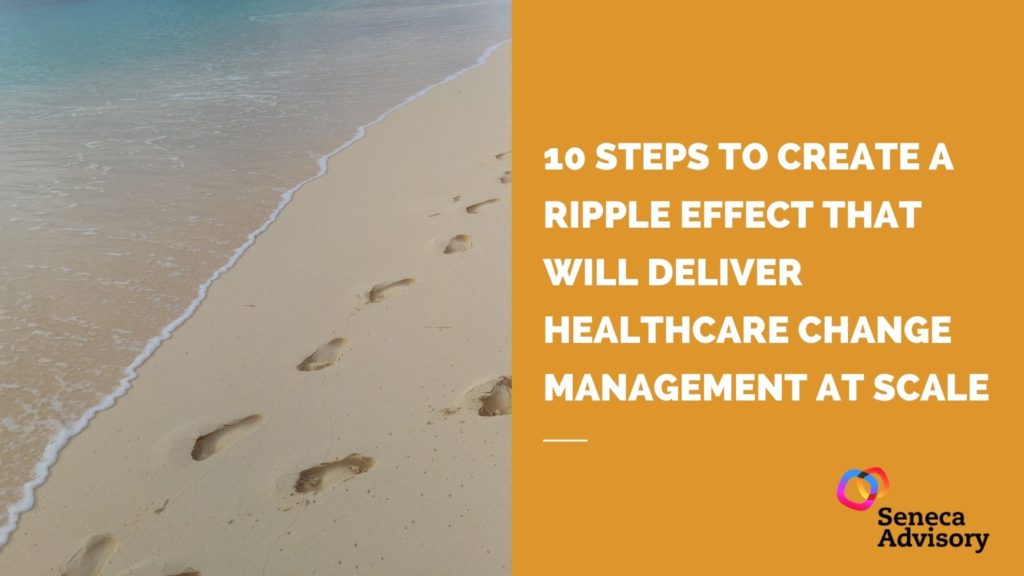10 steps to create a Ripple Effect that will deliver Healthcare Change Management at Scale
by Biliana Barker – Director Seneca Advisory
Remote monitoring, Online consultations, Telemedicine apps, algorithmic questionnaires to navigate patient needs … all this sounds revolutionary, easy and convenient for us, as patients, but at the same time has built the need for a big change by our Clinicians and their practices.
Covid has created a huge opportunity for the patients to shift the way to access care, seek and receive clinical advice, but also created a challenges around the professional identity of the care givers, and raised questions on how to embrace safely the technology and compensate the lack of proximity to our patients.
How the technology and new ways of working will change that identity to help shape new environment in practical terms, will be depending on how we build our Change Management capabilities and we, at Seneca participate in these discussions daily.
We see that our role as implementors is more important than ever before, because will need to fully focus on how to work with healthcare professionals to support them creating new habits, new routines, how to build trust in the process so they confidently can adopt innovations.
Change Management has always been the most complex part of any transformation. Digital Healthcare is even more complicated, with the need for robust clinical safety, data protection and the evidence of outcomes.
With the increase in remote working and the push for digital innovations to assist clinicians and patients, we have now even bigger challenge – How to do it at scale!
How to deliver change management programmes across multiple settings, different operational flows, working styles and cultural specifics. How to achieve wider coverage, have a responsive engagement, encourage proactivity?
There are many approaches that you can deliver at scale and we, at Seneca do this successfully through strong engagement and communications tactics, using powerful stores, that will create Ripple effect.
Find our practical wisdom with ten steps, that will help you improve Change capabilities to deliver at scale.
#Step 1
Fully aligning all of the stakeholders with a common goal of your project and the vision of it, by explaining upfront what is the End Game, what is the change aiming to achieve and how you and your team will support.
#Step 2
Create a “One source of truth”, one communication hub,” One shop stop” that will lead your Scale up Strategy and Implementation. Ensure that other parts of the wider organization are aware of who you are what you do and they also promote your cause.
#Step 3
Confirm Digital ambassadors at every site. You need your Change Management helpers at any level/team/clinic, or department. You may occasionally use them, but important you have your point of contact and communicate to them regularly.
#Step 4
Create a strong co-ordination function in your team, set expectations and tracking mechanisms. The delivery is at scale, but you need to have a log measuring your activities against your plan and any specific KPIs.
#Step 5
Create an Engagement plan throughout the timeframe of the project with all the themes and sessions (6months/12 months). Circulate around. Ensure your stakeholders are aware and have time to book the right participant for the right discussion. With change at scale multiple drop in sessions is a must.
#Step 6
Confirm consistent message, frequently nurturing activities for the participants via sequence of events and comms materials. Create a table to outline what, when and what content will be circulated out. This is helpful for your team and can be ready, and resend to participants if needed at any point. Toolkit with all the comms materials and flow charts is essential and having everything in one place in a simple to access format gives you great ammunitions to deliver better at scale.
#Step 7
Identify and work through champions and involve passionate clinical and non -clinical high performers/influencers to share their experience. Use Q&A and Sharing experience sessions. Avoid wording, that suggests heavy involvement like “ workshop”. Advertise participants to create anticipation. Real stories bring more credibility and authenticity in this journey.
#Step 8
Create meaningful and valuable content, topical events will help focusing on pitfalls, challenges and cultural barriers, pre-conceptions and biases. Construct what are the Top 10 utilisation points that healthcare setting may need help with, e.g recourses and training, response times and operational flow. Specifics always attracts interested audience.
#Step 9
Structure consistent reminders, invites and opportunities to discuss specifics. This allows flexibility and more opportunities for people to engage.
# Step 10
Speak personally to the main players, now this is more possible than ever, building relationships is what will deliver successful implementations. Invite people to come back to you and book one-to-one video sessions. It is very unlikely everybody to come back to you at the same time, but this will give you an opportunity to build relationships outside of the mass webinars and help those, who are truly interested in “making it happen”.
Change Management is about, but limited to winning the hearts and the and building relationships. It is about encouraging people to embrace and develop new habits. The New Habits is what will trigger different actions to bring the change and deliver better outcomes.
Reflecting and learning is this process is key and creating a Lessons Learned Log, when deliver Change management strategies is a powerful journal, that will help you grow as a Change specialist and implementation partner.
Achieving sustainability and long term impact is what would matter for the clinicians and the system in a long term and this can only be done at scale through creating a strong ripple effect.
If you need an implementation advice, or want to share your challenges contact us.
Seneca Advisory is leading Healthcare Digital Transformation partner for the NHS and the Independent providers.
Address
40 Gracechurch Street
London EC3V 0BT


